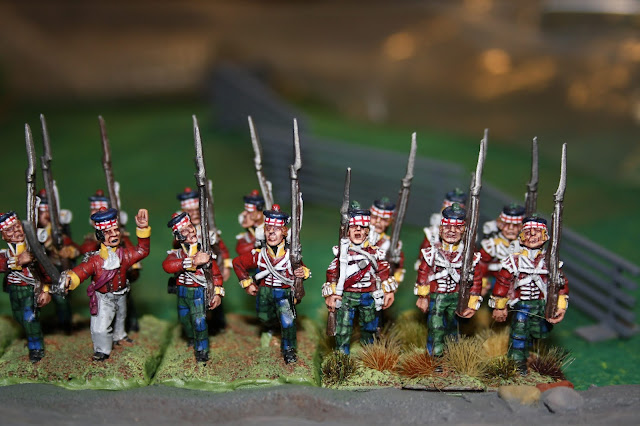93rd Sutherland Highlanders at New Orleans
The Figures
The command group with their Commanding Officer, Lieutenant-Colonel Robert Dale mounted. The C.O. is a modified Victrix mounted highland officer. Basically, I sawed off the feather bonnet head ala the 42nd and replaced it with a OG or KD 93rd bonnet.
Left front; a view of the six man grenadier company with their white touries atop their bonnets. Front right is number one company (four figures each) and the officer leading the number two company.
Numbers seven, eight and nine companies and at the right a sergeant of the light company.
A Brief History and Description of the 93rd Sutherland Highlanders
The 93rd were formed in 1800 as a regular
regiment from the Sutherland Highlanders fencible regiment. They served in Ireland
in 1803, where surprisingly unlike most British regiments, they cemented good relations
with the local Irish. The 93rd earned their first battle honour at in
the expedition to capture the Cape Colony from the Dutch. They were part of
Major-General Baird’s army in the highland brigade along with 71st
and 72nd Highland regiments under command of Brigadier-General Ferguson.
The 93rd and its fellow highlander regiments distinguished themselves
by an amphibious landing while under attack and subsequently defeating the Batavian
army (and 200 French marines) on the fields outside Cape Town.[i]
The 93rd Sutherland Highlanders have often been portrayed
in cinema and paintings as wearing kilts and full Scottish Highland regalia at
New Orleans, not the case. Just prior to leaving their duty station at the Cape
of Good Hope for America via Plymouth England, the 93rd were issued “trews” or tartan
trousers made of “Government” or “Black Watch sett” cloth. This decision was
made in Plymouth while awaiting their departure for America. The tartan was
deemed as “ill calculated for severe service” for the coming operation. Besides,
they were short of ‘about 200 pairs of hose that could not be supplied in the
south of England.’ Coats and equipment were identical in design and cut to
those worn by their European counterparts. Interestingly, their sister 2nd
battalion wore the full highland regalia complete with kilts and feathered
bonnet and hose. The second battalion was stationed in Newfoundland from June
1814 to October 1815 but saw no action.[ii]
Facings were lemon yellow, and the regiment was issued
Hummell or “porkpie” bonnets with wider than normal diced borders bearing a
red-and-white checked pattern later so closely and uniquely associated with its
lineal successor, The Argyll & Sutherland Highlanders. Caps had a tourie or
tuft atop them, red for battalion companies, white for grenadiers, and green
for the light company. Officers’ caps bore a white metal thistle badge.
Blue-gray trousers had been worn in South Africa, these apparently retained by
some officers and supernumeraries.[iii]
Through sheer tenacity the 93rd numbered among the few
British troops to actually reach the American parapet through withering fire.
In so doing it lost three-quarters of its 1008 men in killed and wounded, an
appalling toll.[iv]
One American observer characterized them as “firm and immovable as a brick
wall.” The 93rd were part of Maj-Gen Sir John Keane’s Brigade on the
far left of the British front on or near levee road. In one of his many bad decisions
that day, Major-General Pakenham ordered the 93rd to traverse the field
from left across the front of the American gun line to the right flank exposing
the Scotsmen to sustained cannister fire, which cost them heavily.
[i] The
British Invasion of The River plate 1806-1807, Ben Hughes, pp. 3-17.
[ii]
A
Scarlet Coat: Uniforms, Flags and Equipment of the British in the War of 1812,
Rene Chartrand, Service Publications, 2011, pp 83-84
[iii] Armies of
the War of 1812 by Gabriel Espostio published by Pike and Powder Publishing
Group.
[iv] New Orleans 1815,
Osprey campaign Series, Tim Pickles.
Uniform Plates
Ref: Armies of the War of 1812 by Gabriel Espostio published by Pike and Powder Publishing Group, p. 81.








What a great job you have done on the regiment. Outstanding painting on the bonnet and trousers.
ReplyDeleteYou are most kind Mark. Thanks.
ReplyDeleteAll the best to you,
Rod